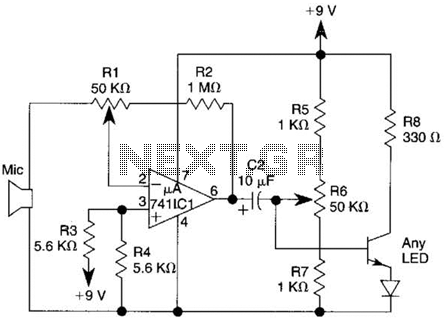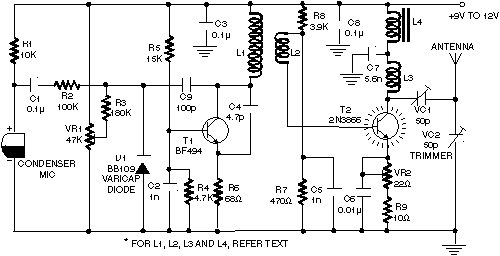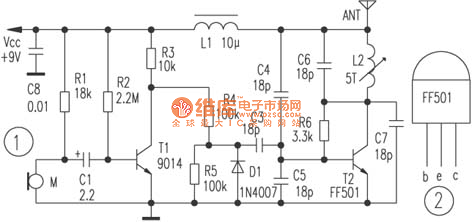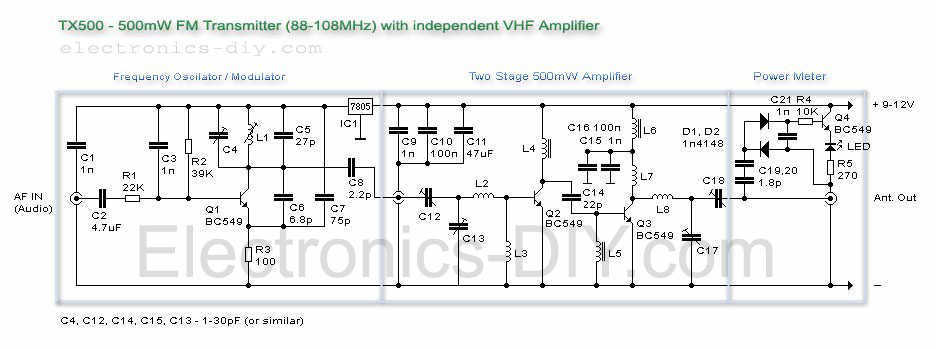
AM transmitter
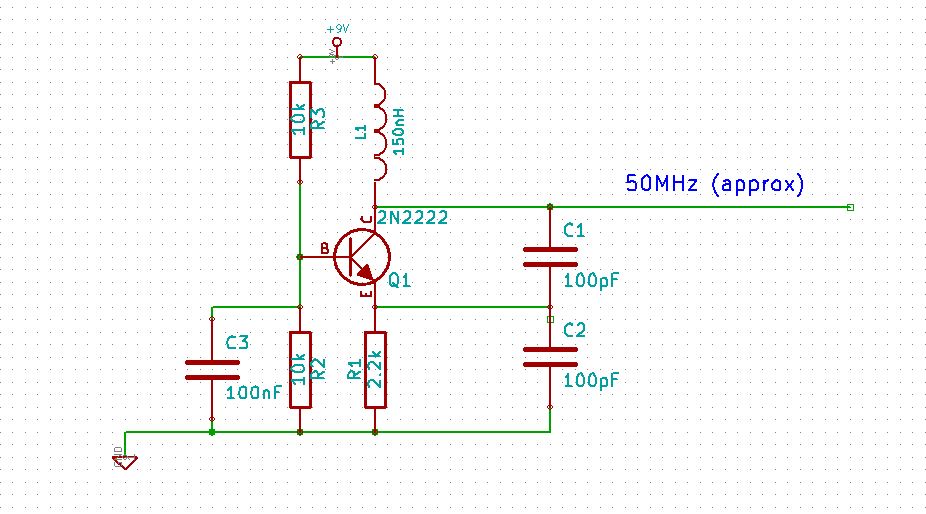
Similar to a square wave, interference with radios can lead to public discontent and may attract the attention of licensing authorities, which should be avoided. A Colpitts oscillator is recommended, featuring a "tank circuit" composed of inductance (L) and capacitance (C) that produces a sine wave. It is advisable to use only the necessary amount of power. It is suggested to select one of the less frequently used AM radio frequencies, as they typically require minimal power for adequate transmission distance. Due to limited coverage in the UK, many listeners resort to internet radio, prompting the need for an expanded internet network. It is crucial to maintain low power levels to avoid disrupting other devices, particularly if the intended receiver is within a 5-meter range. A Clapp oscillator may be preferred for greater stability compared to a Colpitts oscillator, but for generating a 1 kHz signal, a Wien bridge circuit is a suitable choice as it does not require inductance. Careful frequency selection is necessary to prevent interference with established services in the already allocated Radio Spectrum.
The Colpitts oscillator is a type of electronic oscillator that utilizes a combination of capacitors and an inductor to create an oscillating signal. The tank circuit in a Colpitts oscillator is critical for determining the frequency of oscillation, which can be calculated using the formula:
\[ f = \frac{1}{2\pi\sqrt{LC}} \]
where \( L \) is the inductance and \( C \) is the effective capacitance of the capacitors in the circuit. This oscillator configuration is particularly valued for its simplicity and effectiveness in generating sine waves, making it suitable for applications where signal purity is essential.
When designing the circuit, it is important to select components that minimize power consumption while ensuring the output signal meets the desired specifications. Utilizing an AM radio frequency that is less congested can help reduce the likelihood of interference with other radio services. Additionally, the output power should be kept at a level that allows for local transmission without causing disruption to nearby electronic devices.
For applications requiring enhanced frequency stability, the Clapp oscillator can be considered. This variant employs a similar tank circuit but incorporates additional capacitance, which improves the oscillator's performance against variations in temperature and component tolerances. The Clapp oscillator is particularly useful in scenarios where precise frequency control is necessary.
Alternatively, for generating signals at specific frequencies such as 1 kHz, the Wien bridge oscillator is recommended. This oscillator does not rely on inductive components, which simplifies the design and can lead to improved performance in certain applications. The Wien bridge oscillator uses a bridge circuit with resistors and capacitors to establish the desired frequency of oscillation.
Overall, careful consideration must be given to the choice of oscillator type, frequency selection, and power output to ensure compliance with regulatory standards and to minimize the potential for interference with existing radio services.As with your square wave, you will interfere with people`s radios, & they will become quite upset, plus you may attract the attention of the licencing authority-& believe me, you don`t want that! you need I believe a colpits oscilator, this will have a "tank circuit" in it that is the Lc part and will produce a sine wave.
Use only as much power as you need. I`d suggest one of the frequencies used by AM radio as they are seldom used and just enough power to transmit as far as you need. you need I believe a colpits oscilator, this will have a "tank circuit" in it that is the Lc part and will produce a sine wave.
Use only as much power as you need. I`d suggest one of the frequencies used by AM radio as they are seldom used and just enough power to transmit as far as you need. well due the the not excellent coverage in the UK most are forced to listen to the radio via the internet.
I guess that is why we are having to scale up our internet network - just so we can listen to the godamn radio My paramount suggestion is keep the power as low as possible, if it is just a carrier it should not upset reception to other devices too much unless they are the same distance as the intended receiver (5 meters ) I would go for a clapp oscillator as they are a bit more stable than the colpitts but if you only want a 1khz signal a wein bridge circuit would be better as no inductance is required. There are reasons why people don`t just choose frequencies at random to do stuff, & that is because the Radio Spectrum is already allocated to various services, who don`t want your little "drifty" oscillator to interfere with them!
🔗 External reference
The Colpitts oscillator is a type of electronic oscillator that utilizes a combination of capacitors and an inductor to create an oscillating signal. The tank circuit in a Colpitts oscillator is critical for determining the frequency of oscillation, which can be calculated using the formula:
\[ f = \frac{1}{2\pi\sqrt{LC}} \]
where \( L \) is the inductance and \( C \) is the effective capacitance of the capacitors in the circuit. This oscillator configuration is particularly valued for its simplicity and effectiveness in generating sine waves, making it suitable for applications where signal purity is essential.
When designing the circuit, it is important to select components that minimize power consumption while ensuring the output signal meets the desired specifications. Utilizing an AM radio frequency that is less congested can help reduce the likelihood of interference with other radio services. Additionally, the output power should be kept at a level that allows for local transmission without causing disruption to nearby electronic devices.
For applications requiring enhanced frequency stability, the Clapp oscillator can be considered. This variant employs a similar tank circuit but incorporates additional capacitance, which improves the oscillator's performance against variations in temperature and component tolerances. The Clapp oscillator is particularly useful in scenarios where precise frequency control is necessary.
Alternatively, for generating signals at specific frequencies such as 1 kHz, the Wien bridge oscillator is recommended. This oscillator does not rely on inductive components, which simplifies the design and can lead to improved performance in certain applications. The Wien bridge oscillator uses a bridge circuit with resistors and capacitors to establish the desired frequency of oscillation.
Overall, careful consideration must be given to the choice of oscillator type, frequency selection, and power output to ensure compliance with regulatory standards and to minimize the potential for interference with existing radio services.As with your square wave, you will interfere with people`s radios, & they will become quite upset, plus you may attract the attention of the licencing authority-& believe me, you don`t want that! you need I believe a colpits oscilator, this will have a "tank circuit" in it that is the Lc part and will produce a sine wave.
Use only as much power as you need. I`d suggest one of the frequencies used by AM radio as they are seldom used and just enough power to transmit as far as you need. you need I believe a colpits oscilator, this will have a "tank circuit" in it that is the Lc part and will produce a sine wave.
Use only as much power as you need. I`d suggest one of the frequencies used by AM radio as they are seldom used and just enough power to transmit as far as you need. well due the the not excellent coverage in the UK most are forced to listen to the radio via the internet.
I guess that is why we are having to scale up our internet network - just so we can listen to the godamn radio My paramount suggestion is keep the power as low as possible, if it is just a carrier it should not upset reception to other devices too much unless they are the same distance as the intended receiver (5 meters ) I would go for a clapp oscillator as they are a bit more stable than the colpitts but if you only want a 1khz signal a wein bridge circuit would be better as no inductance is required. There are reasons why people don`t just choose frequencies at random to do stuff, & that is because the Radio Spectrum is already allocated to various services, who don`t want your little "drifty" oscillator to interfere with them!
🔗 External reference
